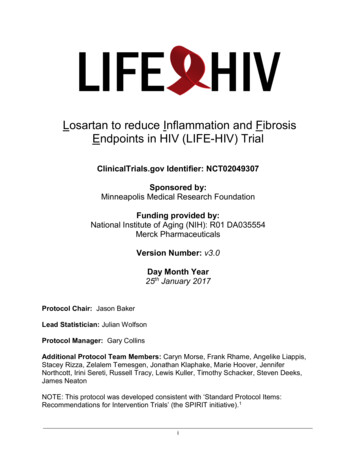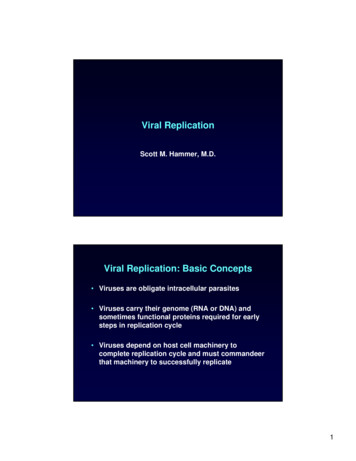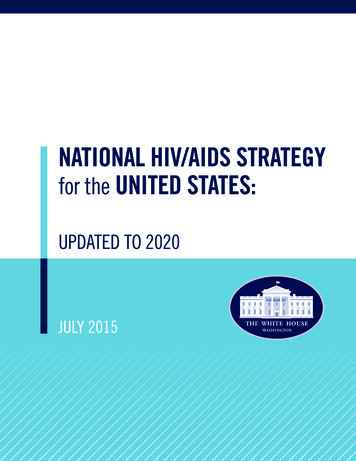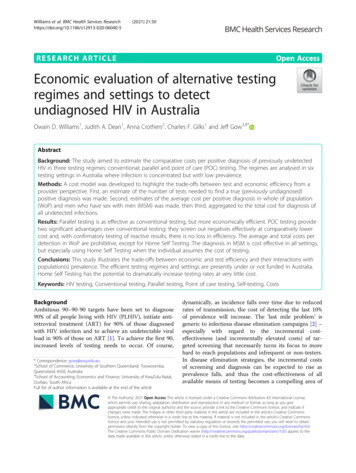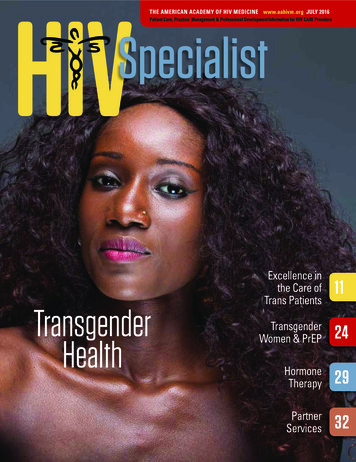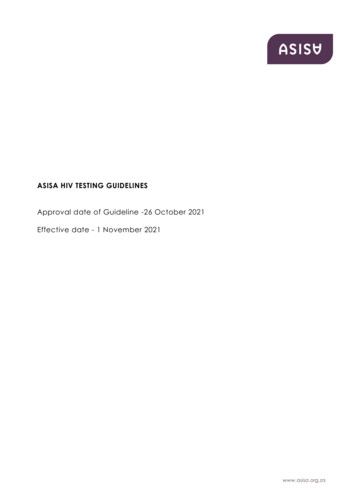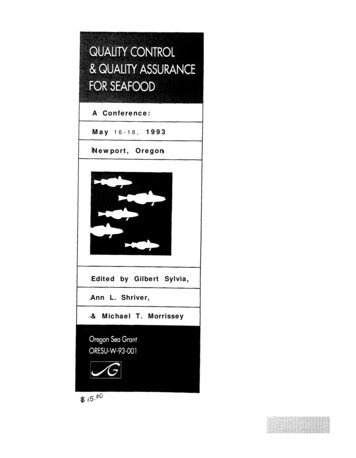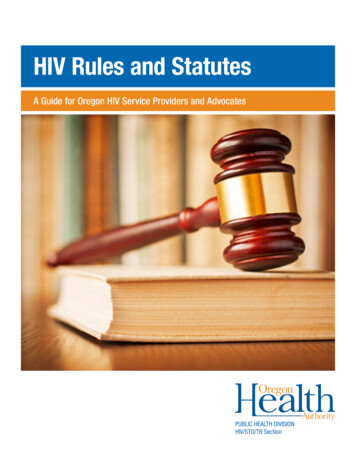
Transcription
HIV Rules and StatutesA Guide for Oregon HIV Service Providers and AdvocatesPUBLIC HEALTH DIVISIONHIV/STD/TB Section
Fifth Edition, January 2017HIV/STD/TB Section, Public Health Division, Oregon Health Authority800 N.E. Oregon St., Suite 1105Portland, OR 97232You can get this document in other languages, large print, braille or a format you prefer. Contact theOHA HIV/STD/TB program at 971-673-0144. We accept all relay calls or you can dial 711.
AcknowledgementsThe Oregon Health Authority, HIV Care and Treatment, HIV Prevention and HIV Data andAnalysis programs would like to thank: Oregon Department of Justice Senior Assistant Attorney General Shannon O’Fallon,who edited this publication Shelley Mactyre for her help developing this document (first edition) as a Lewis andClark Law School student intern The California Department of Health Services Office of AIDS’ 2002 document, “ABrief Guide to California’s HIV/AIDS Laws,” that served as the model for Oregon’soriginal edition of this guide All the people who advocate for the rights of persons living with HIV and their familiesHIV Rules and Statutes: A Guide for Oregon HIV Service Providers and Advocates3
ContentsIntroduction.5Acronyms .5HIV testing.6HIV test consent.6Occupational exposures of health care providers and safety workers.8Substantial exposure of a patient.8Employer programs for HIV prevention, education and testing.9Confidentiality of HIV-related information.10Disclosure of test results.10Medical records.10Information sharing for public health purposes.10Anatomical donations.11HIV and the workplace.12Discrimination in hiring, firing or promoting.12Disability.12Workers’ compensation.12HIV and insurance.12Life insurance.12Health insurance.12General principles applicable to both life and health insurance.13HIV-related education in schools.14Appendix.154HIV Rules and Statutes: A Guide for Oregon HIV Service Providers and Advocates
IntroductionThe Oregon Health Authority, HIV Care and Treatment, HIV Prevention and HIV Data andAnalysis programs are pleased to provide “HIV Rules and Statutes: A Guide for OregonHIV Service Providers and Advocates.” This guide is for providers and advocates servingpersons living with HIV.This guide discusses HIV testing, how HIV-related information can be disclosed and legalemployment and insurance protections for HIV-infected persons. It draws from federaland Oregon state law and from case law. However, it does not provide legal advice orsubstitute for consulting with an attorney.If you need legal help, contact the Oregon State Bar for a referral to an attorney:Oregon State cronymsAIDS: acquired immune deficiency syndromeELISA: enzyme linked immunosorbent assayHIV: human immunodeficiency virusLPHA: local public health authorityOAR: Oregon Administrative RulesOHA: Oregon Health AuthorityORS: Oregon Revised StatutesOYA: Oregon Youth AuthorityPLWH: persons living with HIVHIV Rules and Statutes: A Guide for Oregon HIV Service Providers and Advocates5
HIV testingHIV test consentIn Oregon, a health care provider or his or her designee must notify a patient of an HIV testand give the patient the opportunity to decline (ORS 433.045). This must occur before thepatient is tested or sent for testing. The health care provider or designee can notify thepatient of the HIV test verbally, or in writing using: A consent form for medical treatmentBrochureFact sheetSign-in sheetSignage in a waiting areaThe patient can decline the test verbally or in writing.Insurers, insurance producers or insurance-support organizations that ask applicantsto take an HIV test when they apply for insurance must obtain the applicant’s writtenconsent. The consent form must disclose the test’s purpose and to whom the results maybe disclosed.Anyone other than the individuals or entities above that conduct HIV testing must disclosethe purpose of the test and obtain written consent from the individual (OAR 333-0220205(4)). Required information and permission for HIV testing varies for certain populationsreceiving an HIV test as described below: Pregnant women*It is especially important for pregnant women to know their HIV status. HIV-positivewomen who take recommended HIV medication during pregnancy can reduce therisk of transmitting HIV to their babies to less than 1 percent.In order to determine status, women must be tested for HIV during pregnancy orat delivery. Tests using bodily fluids other than blood that have equal or bettersensitivity and specificity may substitute for the blood test. A woman must consentto give the blood sample and be told that HIV testing will occur. However, no specificconsent for the testing is required. A pregnant woman may decline testing; this mustbe documented in her medical record.* ORS 433.017; OAR 333-019-00366HIV Rules and Statutes: A Guide for Oregon HIV Service Providers and Advocates
Persons who are deceased*If an individual who may have been exposed to a deceased person’s blood or bodilyfluids requests testing, next of kin may consent to an HIV test.If the medical examiner has jurisdiction over a death, he or she can orderblood or urine samples for testing without other authorization (ORS 146.113).The medical examiner must investigate and certify the following deathcircumstances (ORS 146.090): From apparent homicide, suicide or that occurs under suspicious orunknown circumstances Resulting from unlawful use of controlled substances or the use or abuse ofchemicals or toxic agents Occurring while incarcerated in any jail, correction facility or in police custody Appearing accidental or that follows an injury From disease, injury or toxic agent during or arising from employment While not under the care of a physician immediately before dying Related to disease that might be a threat to the public health In which a human body apparently has been disposed of in anoffensive manner**Persons who are incapable of consenting†If the person is not able to consent to an HIV test, that individual’s personal representativemay consent on his or her behalf.* OAR 333-022-0205(5)** “Offensive manner” means a manner offensive to the community’s generally accepted standards.†OAR 333-022-0205(6)HIV Rules and Statutes: A Guide for Oregon HIV Service Providers and Advocates7
Occupational exposures of health care providers andsafety workers*If a “worker”** has a substantial exposure† to another person’s (the “source person’s”)bodily fluids, knowing whether the source person has HIV can help the worker decidewhether to obtain treatment to help prevent HIV infection (post-exposure prophylaxis). Theworker should take post-exposure prophylaxis within 72 hours of an exposure for it to beeffective.Eligible workers who have experienced a substantial exposure can request HIV testing ofthe source person if the exposure is determined to be work-related (occupational). Theprocess to request testing for a source person is found in OAR 333-022-0300. If afterfollowing the process to request an HIV test, the source person refuses to consent to thetest, the health care provider or safety worker can petition the circuit court to order testing.The petition process is described in OAR 333-022- 0305.Substantial exposure of a patient‡If a patient has an exposure to the blood or other bodily fluids of a “worker,” the workermust report the exposure to a supervisor or employer, or other persons specified in staterules. If the exposure is determined substantial, the patient can request information aboutthe worker’s HIV status. If the status is not known, the patient can ask the worker toconsent to an HIV test. The process that a worker and the patient must follow is set out inOAR 333-022-0310.* ORS 433.065 – 433.080; OAR 333-022-0300** “Workers” include persons licensed or certified to provide health care (under ORS chapters677, 678, 679, 680, 684 or 685, or ORS 682.216); employees of licensed health careproviders, health care facilities or clinical laboratories (defined in ORS 438.010); firefighters; lawenforcement officers (defined in ORS 414.805); and corrections, parole or probation officers(OAR 333-022-0300).†“Substantial exposure” means an exposure to blood or certain body fluids that have a potentialfor transmitting HIV based on current scientific information. Substantial exposure may includebut is not limited to contact with an exposed person’s blood or blood components, semen,vaginal/cervical secretions through percutaneous inoculation or contact with an open wound,non-intact skin or mucous membrane (OAR 333-022-0300(1)).‡ORS 433.065; OAR 333-022-03108HIV Rules and Statutes: A Guide for Oregon HIV Service Providers and Advocates
Employer programs for HIV prevention, education and testing*The OHA Public Health Division approvesemployer programs that provide HIVprevention, education and testing toemployees. Such programs must includecounseling regarding: Preventing HIV infectionUniform body fluids precautionsSexual/needle-sharing abstinenceSafer sex practices, including adviceabout how to protect partners fromexposure to body fluids while HIV testresults are pendingEmployers may submit written requeststo the OHA Public Health Division foreducational materials.Employers offering HIV testing to employees must use a laboratory certified to performtesting on human specimens under the Clinical Laboratory Improvement Amendments of1988 (P.L. 100-578,42 U.S.C. 201 and 263(a))(CLIA).If an employer does not offer HIV testing and a worker is exposed to body fluids, theemployer shall provide the exposed worker with the name and contact information ofa health care provider to perform testing. An exposed worker may also seek medicaltreatment from a health care provider of his or her choice.* ORS 433.075(4); OAR 333-022-0315HIV Rules and Statutes: A Guide for Oregon HIV Service Providers and Advocates9
Confidentiality of HIV-related information*Disclosure of test resultsThe identity of any individual tested for HIV, or the results of an HIV test that couldidentify the person tested, may not be disclosed in most cases. The person may onlybe identified if he or she authorizes it or if federal or state law permits it. This does notapply to an individual acting in a private capacity, such as an infected individual telling asexual partner.HIV test results may be disclosed to: The tested individualThe health care provider or licensed health care facility or person ordering the testAnyone the tested individual authorizes to receive the results.Medical recordsA health care provider or licensed health care facility may enter HIV test results into anindividual’s routine medical record. This information must be disclosed per ORS 192.553 to192.581 and the Health Information Portability and Accountability Act (HIPAA) regulations,45 CFR 160 to 164.Information sharing for public health purposesThe OHA Public Health Division and LPHAs use reported HIV case information to monitorHIV’s prevalence in the state. This information also helps determine activities to protectand improve public health. Laboratories and health care providers must report all HIVpositive test results to the LPHA or to OHA (OAR 333, Division 18; OAR 333-019-0031).Anyone may report an individual’s identity and HIV test result to the LPHA or to the OHAPublic Health Division for public health purposes (OAR 333-022-0210).* ORS 433.045; OAR 333-022-021010HIV Rules and Statutes: A Guide for Oregon HIV Service Providers and Advocates
The OHA Public Health Division or LPHA may inform people if they have had a substantialexposure to HIV. This may only occur if clear and convincing evidence shows thatdisclosure will avoid an immediate danger to the individual or to the public. The OHA PublicHealth Division or LPHA may disclose the identity of an individual with an HIV-positivetest to a health care provider to aid treatment. These disclosures may include only theminimum amount of information necessary to carry out the disclosure’s purposes (OAR333-022-0210).Anatomical donations*An anatomical donor’s identity and HIV test results may be released to a healthcare provider or licensed health care facility. This disclosure may include only theminimum amount of information necessary to prevent contaminated anatomical parts’transplantation into other individuals.* OAR 333-022-0210(5)HIV Rules and Statutes: A Guide for Oregon HIV Service Providers and Advocates11
HIV and the workplaceDiscrimination in hiring, firing or promoting*An employer or prospective employer may not discriminate against an employee becausethe employee has HIV.DisabilityA positive HIV diagnosis may be a disability for employment. Therefore, an HIV-infectedemployee may be entitled to reasonable accommodation and continued employment. SeeBragdon v. Abbott 524 US 624, 118 S Ct 2196 (1998).Workers’ compensationA workers’ compensation claim constitutes an authorization for release of medical records.This does not include HIV-related information protected by ORS 433.045, which requires aspecific authorization.HIV and insuranceLife insuranceAll life insurance policies, except those covering specific diseases only, must cover HIVinfection, including AIDS (OAR 836-050-0210(2)).Health insuranceHealth insurance policies, except those covering specific diseases only, must cover HIV/AIDS infection (OAR 836-050-0210(1)). Asymptomatic HIV infection is not a preexisting condition.For subsequent claims relating to AIDS, asymptomatic HIV infection is not a preexisting condition (OAR 836-050- 0215(1)). Period of exclusion for HIV claimsThe period of exclusion for HIV infection claims may not be longer than for otherpre-existing diseases (OAR 836-050-0215(2)).* OAR 839-006-024012HIV Rules and Statutes: A Guide for Oregon HIV Service Providers and Advocates
General principles applicable to both life and health insurance* Application for coverageThe insurer may not inquire about an applicant’s sexual orientation (OAR 836050-0240(1)). Asking medical questions about or requiring testing for HIV or AIDSis not allowed unless the applicant is also asked about or tested for other healthconditions (OAR 836-050-0240(4)). However, testing for HIV is allowed if anapplicant answers “yes” to whether he or she has tested positive for HIV or beendiagnosed with HIV or AIDS. Testing for HIVInsurance cannot be denied or rated based on an HIV test unless:Two positive test results exist that used a specific testing protocol approved bythe state epidemiologist orThe applicant declines retesting or fails to respond to a request for retesting(OAR 836-050-0250). Inquiries about past HIV testingAn insurer may inquire whether an applicant has tested positive for HIV but may notinquire generally about whether the applicant has taken an HIV test. An insurer maynot rate or deny coverage unless it has followed the testing protocols referred toabove or unless the applicant declines retesting or fails to respond to a request forretesting (OAR 836-050-0255(1) and (2).HIV Rules and Statutes: A Guide for Oregon HIV Service Providers and Advocates13
HIV-related education in schools*Each Oregon school district shall provide an age-appropriate, comprehensive plan ofinstruction** on human sexuality, HIV/AIDS and sexually transmitted disease (STD)prevention in elementary and secondary schools.The comprehensive plan of instruction shall: Be approved by the local school board Promote abstinence for school-age youth, without stigmatizing students who havehad or are having sexual relationships Promote mutually monogamous relationships with an uninfected partner for adults,as the safest and most responsible behavior to reduce the risk of unintendedpregnancy and exposure to HIV, hepatitis B/C and other STDs Teach the characteristics of healthy relationships§§Be balanced† and medically accurate‡Avoid shame- or fear-based tactics§Include HIV and STD prevention education at least annually to all students grades6–8 and at least twice during grades 9–12* OAR 581-022-1440** “Comprehensive plan of instruction” (defined by Oregon education statutes) means K–12programs that emphasize abstinence but do not exclude condom and contraceptive skills-basededucation. The human sexuality information provided is complete, balanced and medicallyaccurate. The curriculum encourages young people to develop and understand their values,attitudes, beliefs and decisions about sexuality. It helps young people exercise responsibility insexual relationships and sexual health decisions.†“Balanced instruction” provides a variety of information, including whether the information isevidence-based or anecdotal.‡“Medically accurate instruction” includes information established by using the scientific method.Results can be measured, quantified and replicated to confirm accuracy and are reported orrecognized in peer-reviewed journals or other authoritative publications.§“Shame- or fear-based tactics” are terminology, activities, scenarios, context, language and/or visual illustrations used to devalue, ignore and/or disgrace students who have had or arehaving sexual relationships. Not all curricula or activities that describe risks of sexual activitiesare fear-based.§§“Healthy relationship” is one in which both people feel a healthy sense of “self.” Each personfeels comfortable and safe when spending time with the other. Two individuals try to meet eachother’s needs. Each can ask for help and support within and outside the relationship without fearof criticism or harm.14HIV Rules and Statutes: A Guide for Oregon HIV Service Providers and Advocates
Use inclusive materials and language that recognize different cultures, sexualorientations, and gender identities and expressionsSee OAR 581-022-1440(6) for additional requirements.A district school board may establish a course of education about STDs. Any parent mayask the school to excuse his or her child from the instructional program (ORS 336.035(2)).AppendixOregon Revised Statutes:Available online at http://www.leg.state.or.us/ors/Oregon Administrative Rules:Available online at http://arcweb.sos.state.or.us/banners/rules.htmOHA HIV/STD/TB Program800 N.E. Oregon St., Suite 1105Portland, OR 97232Phone: 971-673-0153Fax: 971-673-0178Website: http://bit.ly/HIV-STI-VHHIV Rules and Statutes: A Guide for Oregon HIV Service Providers and Advocates15
PUBLIC HEALTH DIVISIONHIV/STD/TB SectionYou can get this document in other languages,large print, braille or a format you prefer. Contactthe OHA HIV/STD/TB program at 971-673-0144.We accept all relay calls or you can dial 711.OHA 9342 (01/17)
This guide discusses HIV testing, how HIV-related information can be disclosed and legal employment and insurance protections for HIV-infected persons. It draws from federal and Oregon state law and from case law. However, it does not provide legal advice or substitute for consulting with an attorney.


